ELVIS ON TOUR
FILM DOCUMENTAL 1972
"ELVIS ON TOUR" Film.
De Tupelo a Memphis 68.
Elvis On Tour. The Rehearsals
https://go.ivoox.com/rf/74749828
De Tupelo a Memphis 69
"Elvis On Tour".
The Concerts. Abril 1972.
https://go.ivoox.com/rf/76162198
"ELVIS ON TOUR"
March and April 1972..
All this in a logical and natural way, spontaneously so that the two directors of the documentary asked Elvis, naturally, sincerely, to do what was normal at all times, without a pose, without looking like an actor, they even told him that if they noticed some falsehood would turn off the camera and the project would be left aside. The making of the film was divided into parts of rehearsals and studio recordings and also during concert performances.
The part of the rehearsals and recordings was done in studio C of the RCA, in Hollywood, for the MGM, during the days March 30, 31 and April 5, 1972. And the rest of the filming was done on April 9, 10, 14 and 18, 1972, during this month's Elvis on Tour performances.
Those responsible for the making and directing of this film would be two young directors, Pierre Adidge and Robert Abel, who were highly talented. They wanted to make a documentary film about Elvis Presley, the myth that even after years continued to perform successfully in concerts and had the favor of his audience.
The production cost of it would be a total of 1.6 million dollars, although Elvis would actually take a million dollars to make it, which would be the biggest expense. The profits would recover this investment, just three days after its release in theaters and it was really curious, since these types of documentaries were not attractive in theaters, but Elvis was.
It would also be a success for critics and would win the award for best documentary, the Golden Globe. It would also reach 13th place in the Variety National Box office Survey, which was the American weekly dedicated to the world of entertainment.
The film was made at MGM and was another documentary that could resemble the one made in 1970 "That's the way it is", but the reality was different. Robert Abel, director of this film, was a pioneer in visual effects, animations and interactive media, in the 1960s to 70s.
Abel wrote and directed several movies apart from "Elvis on Tour", "The Making of the President, 1968", "Let the Good Times Roll", etc. He founded his own company "Robert Abel and Associates" in 1971, to make commercials and movies, including computers to preview his effects, developing his own software for digital animation movies.
Apart from the Golden Globe award, he also received other important awards such as the Emmy Award. Pierre Adidge, also a director, screenwriter, producer, also with a successful career, had directed "Mad Dogs & Englishmen", "The Racing scene", et.
Pierre would associate with Abel, due to the mutual interest in being able to learn more about the man who had become a legend. In this film, a young man named Martin Scorsese also collaborated in the editing supervision, who over time would make his own films as a director. , screenwriter and producer. Titles like "Taxi driver", "New York, New York", "Raging Bull", etc.
Another curiosity would be in the assistance of the post production of the film, the collaboration of Jerry Shilling, friend and trainer of Elvis. He already had experience in Hollywood and it was proposed to include him as an assistant also because of his professional career and his closeness to Elvis.
The costumes were made by Bill Bellew and scenes from several of the concerts he was going to perform during the month of April 1972 were included. Elvis, Vernon Presley, Joe Esposito, Jerry Schilling, Sonny West, Red West, James Caughley, Lamar Fike, and Marvin Gamble.
We can see all of them in many moments of the film, next to Elvis. Although Elvis wanted to do his job well at all times, having the camera behind him at all times would surely end up bothering him, since this was not a normal movie. .
The rest got used to it, because they were really mere extras on the screen, but Elvis was captured by the filmmakers at all times.
"Following the Path of the King..."
ELVIS ON TOUR. The Rehearsals
March 30, 31 and April 5, 1972. RCA Studios C in Hollywood and Bufallo. In these days of rehearsals and recordings, Elvis would be focused on the repertoire of songs that he is going to perform during the April concerts. Elvis had a new project and was excited about the filming of the documentary "On Tour", which will be made on the occasion of these concerts.
Two young filmmakers named Bob Abel and Pierre Adidge, a couple of young music lovers, who were determined to reveal the true soul of the artist, through this documentary. They had already made another documentary film about the artist Joe Cocker in 1970.
In these three days we can see Elvis with his team of musicians, recording and pouring themselves into these rehearsals. In the interview, he reached the depths that he could feel, although Elvis had recently separated, these days his past had even more weight and these two filmmakers made him look back. They asked him about his beginnings, about the public, about music and we will be able to hear in Elvis's own voice his thoughts, which for years led him to feel used and sick, during the time he made movies.
Although finally only a small part of this interview would come out in the documentary, by order of the Colonel, since this would not have been good for the image of Elvis, even if it was the reality of his vision. We will also be able to listen to the Gospel improvisations that they performed with Elvis, JD Sumner, Los Stamps and Charlie Hodge, all around the piano, magical moments that arose from the improvisation of the moment...
"Following the Path of the King..."
Elvis on Tour
From rehearsal to concert
March 30, 31 and April 5, 1972, From Rehearsal to Concert.
Confessions of the Soul.
Interview with the real Elvis
The documentary "Elvis On Tour" made in March-April 1972, would not only show the rehearsals, performances and recordings of Elvis Presley in concert. There is an essential part, which, although it was cut out in the documentary for convenience, would perhaps be the most personal and sincere side of the artist who would finally speak honestly about his thoughts, about his feelings in front of a camera. Actually Elvis Presley had no intention of doing an interview, he had given his consent but he was not very fond of talking about himself and even less so, with a camera.
He did not like this type of filming, really he never went to advertise on any TV program, for example, only to act. His way of being was too modest and in his particular way of life, he was not interested in telling more than was necessary.
But when the time came he had agreed to ask him some questions about his professional life and he accepted. Pierre Adidge, the director of the film, wanted to know more than just the image of the artist and asked him about his career, his musicians, his performances, they wanted to know much more about him, because in the early days they saw Elvis as a sincere person. .
For this reason, in their desire to know more, they spoke of a more serious interview. It is true that Elvis at first never thought that such an interview would be given, but finally it was done and this would be testimony to a great truth. They spoke in general about his profession, his beginnings, situations he had experienced years ago and little by little the conversation got out of hand, when he asked him about his career and Elvis began to remember his beginnings.
In these moments Elvis returned to the past and as if he were confessing, he uncovered thoughts and feelings that no one had heard until then.
Elvis talked about the early days, the fans and his humiliation on TV. In his memory he recalled when they made him sing in a tuxedo and sing to a dog, he never agreed. They even made him cover himself with a top hat on the Steve Allen Show. It is true that in many of these programs, the trend was to perform comic scenes, so he admitted as one more singer who performed this type of collaboration.
Actually, many famous people of that time did it and no one would feel offended with this because it was usual, to act with the rest of the cast of the program in some number. But another thing would be to ask him that during his own performance for which he had been called to the program as an artist and singer, they make him dress as he did not want and others.
For Elvis, this meant contempt for his performance and really as he allowed himself to be handled, although he did not object, he felt obliged to do so. When asked about the time of the movies, although it was his greatest desire to be an actor, he regretted the films he had to interpret.
Elvis said that all the films made were the same, with different names, pathetic songs and insignificant scripts. He was asked why he agreed to do scripts that didn't bring him anything and that he didn't like, just like the songs he didn't feel... he said he was forced to do it. His opportunity to show his acting skills was burned in these years , repeating over and over again, these films, which made him sick, which embarrassed him.
Elvis said that he felt "sick", his discouragement was such that for years he was mired in constant dissatisfaction, because he said he had to do it. His sincerity and confession came as a complete surprise to directors Adidge and Abel, who expected nothing more than simple answers.
They really got much more than expected, but the purpose of the documentary, although it was to show the reality about the artist Elvis Presley, surely it was not what was expected. When the Colonel saw the tape and heard what Elvis had been saying in the interview for the documentary , he was very upset. It was clear that he would not allow it to be included in the film, because you could not offer that confession or admit that his films were bad or suggest that he lacked talent. Due to the influence of Colonel Parker, as well as that of the two directors of the film , much of this interview was cut and left in the background, because they did not know how far the transparency of Elvis was going to go.
It was not what was expected, not only because it did not damage the image, but because the documentary did not have this intention. But the total recording in which Elvis can be heard talking about all this, was saved outside the documentary for testimony of the great truth with which Elvis Presley lived.
The truth about him, his great Ferris wheel in which he climbed and for years did not stop turning...
"Following the Path of the King...
"From Tupelo to Memphis 68.Elvis On Tour.
The Rehearsals
https://go.ivoox.com/rf/74749828
https://www.youtube.com/watch?v=H0QXSMgssCU
https://www.youtube.com/watch?v=kSD19igmbco
Interview for "Elvis On Tour" 1972
ELVIS PRESLEY interviewed by Director Pierre Adidge, for the making of the documentary film.
ELVIS ON TOUR
The Repertoire. April 1972.
Songs like "I John", "Bosom of Abraham", "You Better Run"... "I'll Remember You" was recovered from the songs of the late 60's and returned to the tour. Many songs added from the 50s, but interpreted in another way, another way of acting, so as not to be anchored in the past. Elvis would often group several of his early works together and perform them in quick succession near the beginning of the show. The public immediately responded with euphoria upon recognizing these songs and somehow it was necessary to include them in the show. The difference was the way in which the songs were handled, the speed, the air with which they were interpreted would be different from the previous one. Elvis shone with songs "Love me", like "Heartbreak Hotel" although he already gave him another intention, "All Shook Up", etc But in some cases he didn't fully interpret the song because it was as if he wanted to pass by other songs that might interest him more in the present.
The repertoire was varied, with old and current songs and also different styles, rock, gospel, pop, etc. It could be an important moment for Elvis to be able to carry out his dreams as an artist and to be able to offer the world a good concert.
His strength, his artistic soul and all his interest would make these unique moments in concert, magic for his audience that followed him and loved him unconditionally.
His song selection on tour mostly mirrored his recent performance in Las Vegas, albeit with some new numbers being introduced. "Burning Love" was tried out in a few cities, although Elvis had trouble with the lyrics, for some reason this song had choked him and he couldn't or wouldn't memorize the sheet music and had to rely on holding a sheet during the song.
Despite the occasional hiccups in performances, even if the audience can't see it, things always happen, it's still amazing that Elvis performed close to thirty songs per show, for an hour or more each time. The show developed without rest and also taking into account the general effort that both Elvis and the entire group of musicians, choristers, etc. had.
It was just him and a band playing in real time, working from memory a set list made up of thirty years of music in a variety of styles. It was an absolutely amazing show.
The song was inspired, albeit unconsciously, by Elvis's hit "A Big Hunk or "Love", which had suddenly found its way back into the Elvis repertoire, albeit performed faster.
Elvis, when he recorded "Burning Love", added a "hunka hunka" at the end of the song, which could be interpreted as a clear reference to the previous hit. And of course we must highlight the inclusion of Gospel songs, accompanied by DJ Sumner with the Stamps, moments in which Elvis lost himself inside to listen to the background of himself inspired by these songs that are so special to him. Another of the particular moments of these concerts would be the interpretation of the song "An American Trilogy", with which it can be said by the enthusiastic applause of the public, that the audience feels proud to be American.
All these moments would be worth remembering in these performances and in future ones that Elvis Presley was going to perform.
"Following the Path of the King..."
The songs of the Soul.
The Gospel.
The Gospel, would be the style of music that Elvis preferred to sing. He was a lover of Gospel, this music was rooted in him since he was a child and, whenever he heard these songs being sung, Elvis was absorbed in his thoughts. Inside him, this type of music transported him, elevated him to another dimension. At least this is what it looked like when he sang. All those who saw him perform in a Gospel song realized that his involvement in these scores was much more. When Elvis performs Gospel, he is always leaving his soul, his skin in that song, he really is so inspired that he seems to escape from reality.
At this time in his life, Elvis often took refuge in his spirituality, in his books and this music would also be a refuge within him.
Music is sometimes something inexplicable, the feeling it produces in us, the emotion that floods us, is so great that being a musician sometimes becomes an obsession, almost an incurable disease. A search that is sometimes unattainable, that you try to feel again at all times...
For an artist as exceptional as Elvis Presley, Gospel could be that magnet, that sensation so special, so great that there was no comparison with other types of songs. In this movie "Elvis On Tour", he is seen like this at times, both in rehearsals and on stage when he listens to the choir. An example would be during the performance of the song "How Great Thou Art", when he sings it in front of the public.
He performed it on many occasions and it was very special music for him. You just have to see his face and feel that sweet look, that emotion contained smile to know what it meant to him. For example when J.D. Sumner and the Stamps sing "Sweet, Sweet, Spirit", also on stage. His tour. This exciting session was recorded for the documentary "Elvis On Tour" by the directors, Pierre Adidge and Robert Abel, at RCA studio C for MGM in Hollywood. He would sing several Gospel songs: "Turn your Eyes Upon Jesus / Nearer my God to Thee", "The Lighthouse", "When its my time", "Bosom of Abraham", "Lead Me, Guide me", "You better run", "Sweet Sweet Spirit", "Must Jesus Bear The Cross Alone".
Elvis performed on these piano jams with J.D. Sumner, The Stamps and Charlie Hodge.
It was a special moment, unscheduled or at least one of rapport for all of them and of fun. A moment to share that great sensation, that special feeling, the image is wonderful, to see how everyone enjoys the Gospel. Elvis would not be a composer, but he had plenty of soul and inspiration to sing and transmit his music in a unique and incomparable way. The truth is that he interpreted any style without equal, but it is clear that for him, Gospel music was something so great, that it made him so sensitive and special... that it would be difficult to explain.The soul of the artist
"Following the Path of the King..."
https://youtu.be/zxLSG4uoJPM
ELVIS ON TOUR. The Rehearsals
LOn March 30, 31 and April 5, 1972, the rehearsals and recordings that can be seen in the documentary film "Elvis on Tour" would take place.
-

-

-

-

-

-
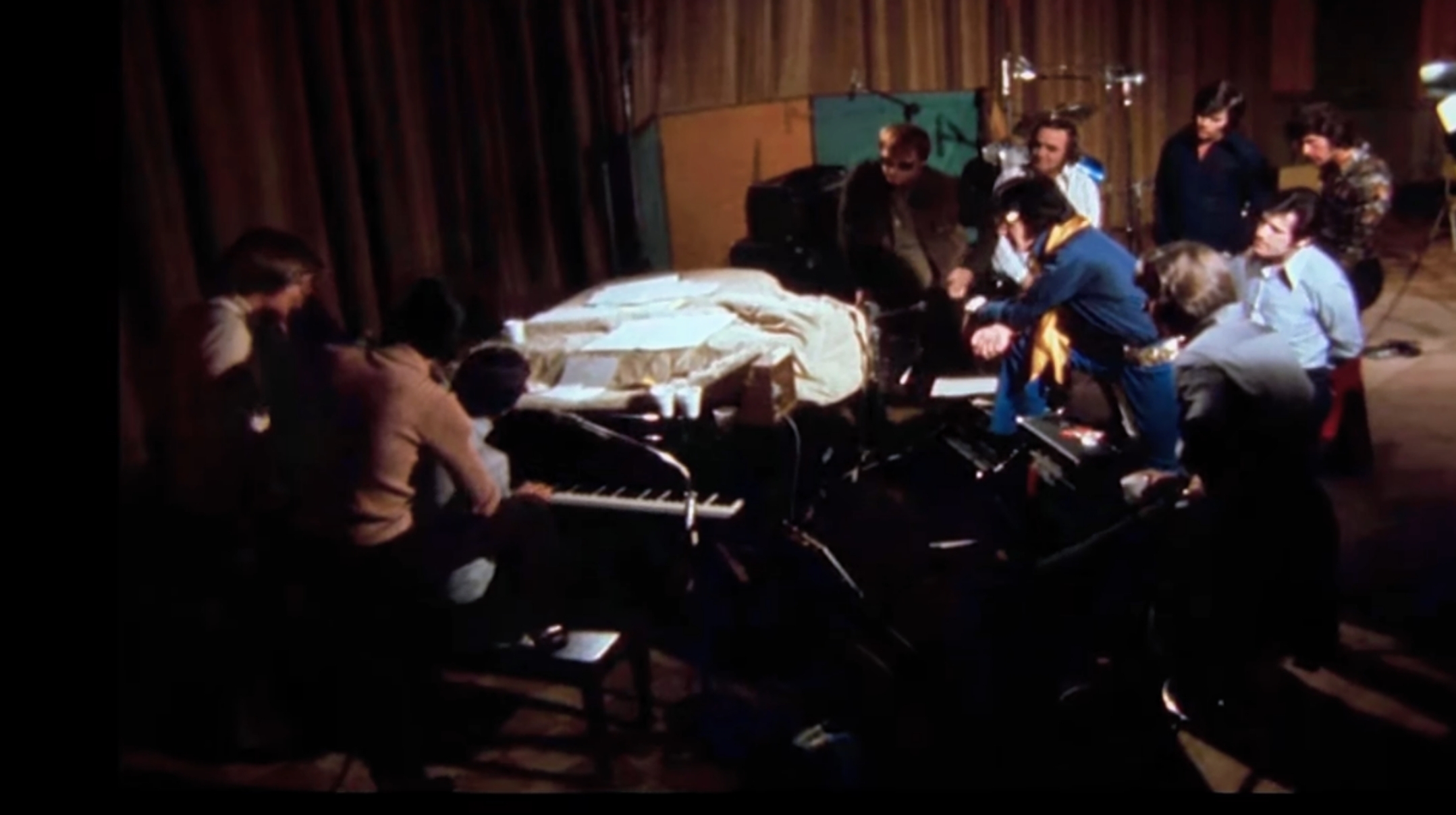
-

-

-

-

-
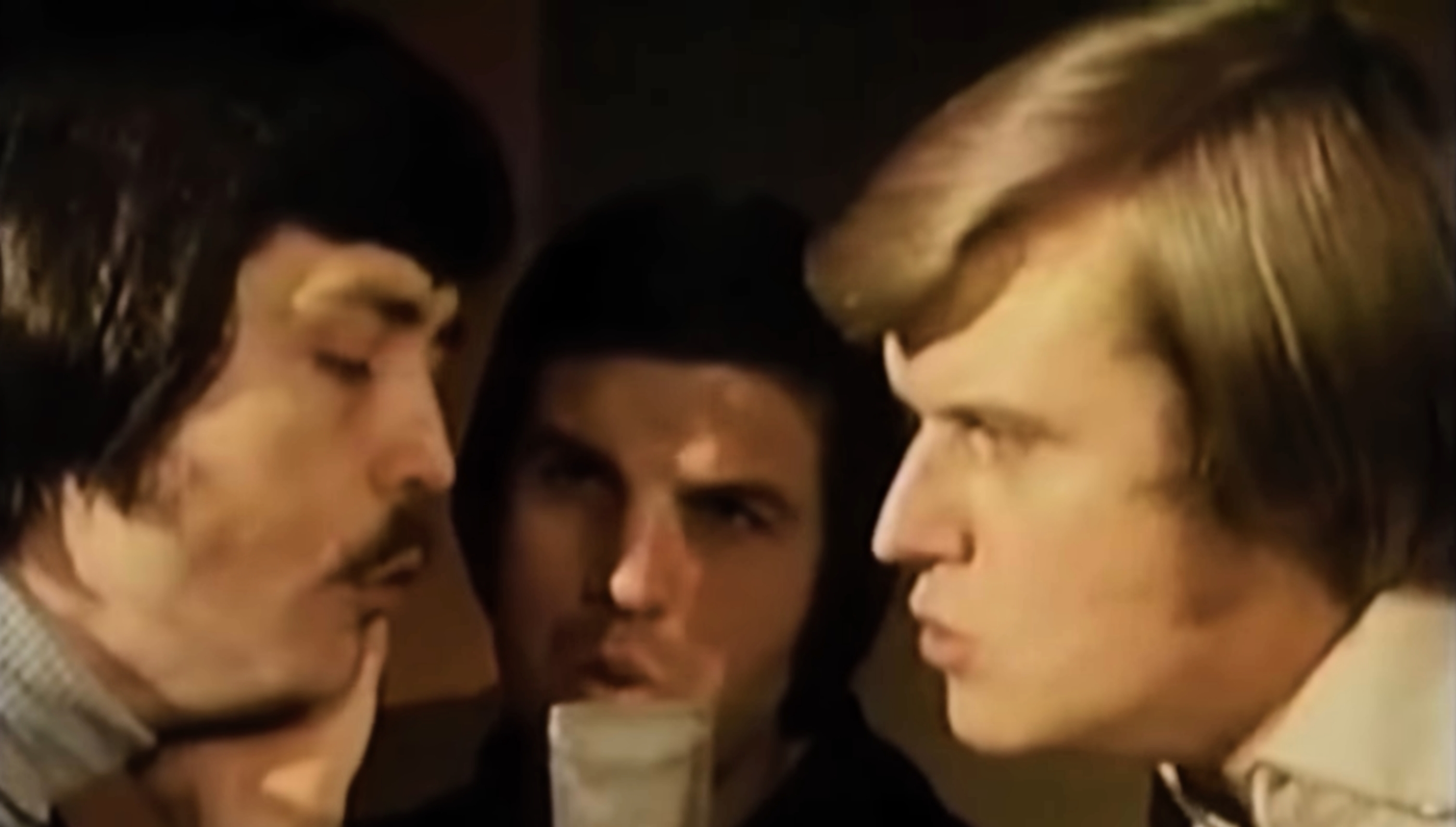 Elvis on Tour The Rehearsals Marzo de 1972 Estudios RCA Hollywood.
Elvis on Tour The Rehearsals Marzo de 1972 Estudios RCA Hollywood. -

-

-

-
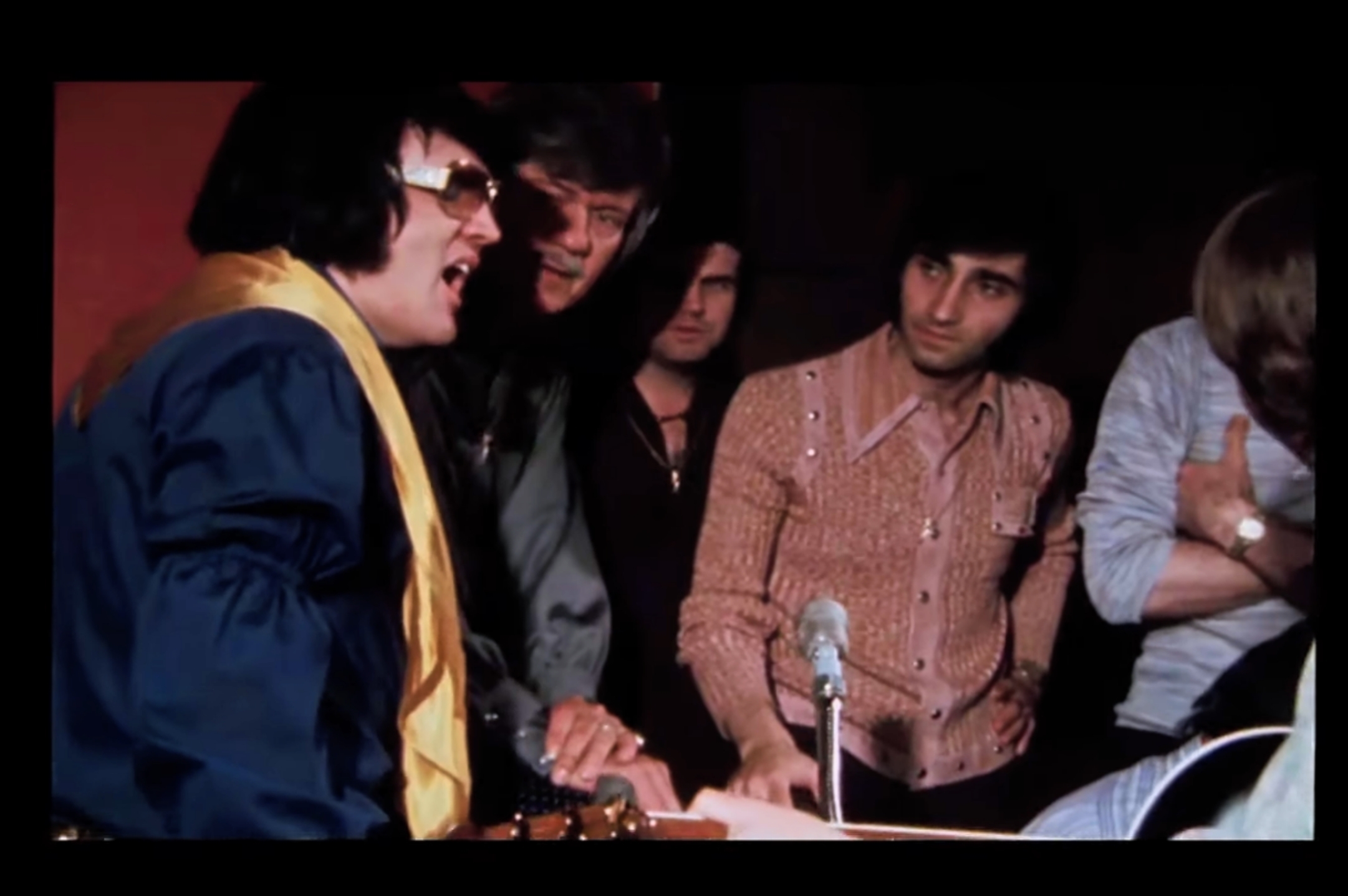
-

-

-
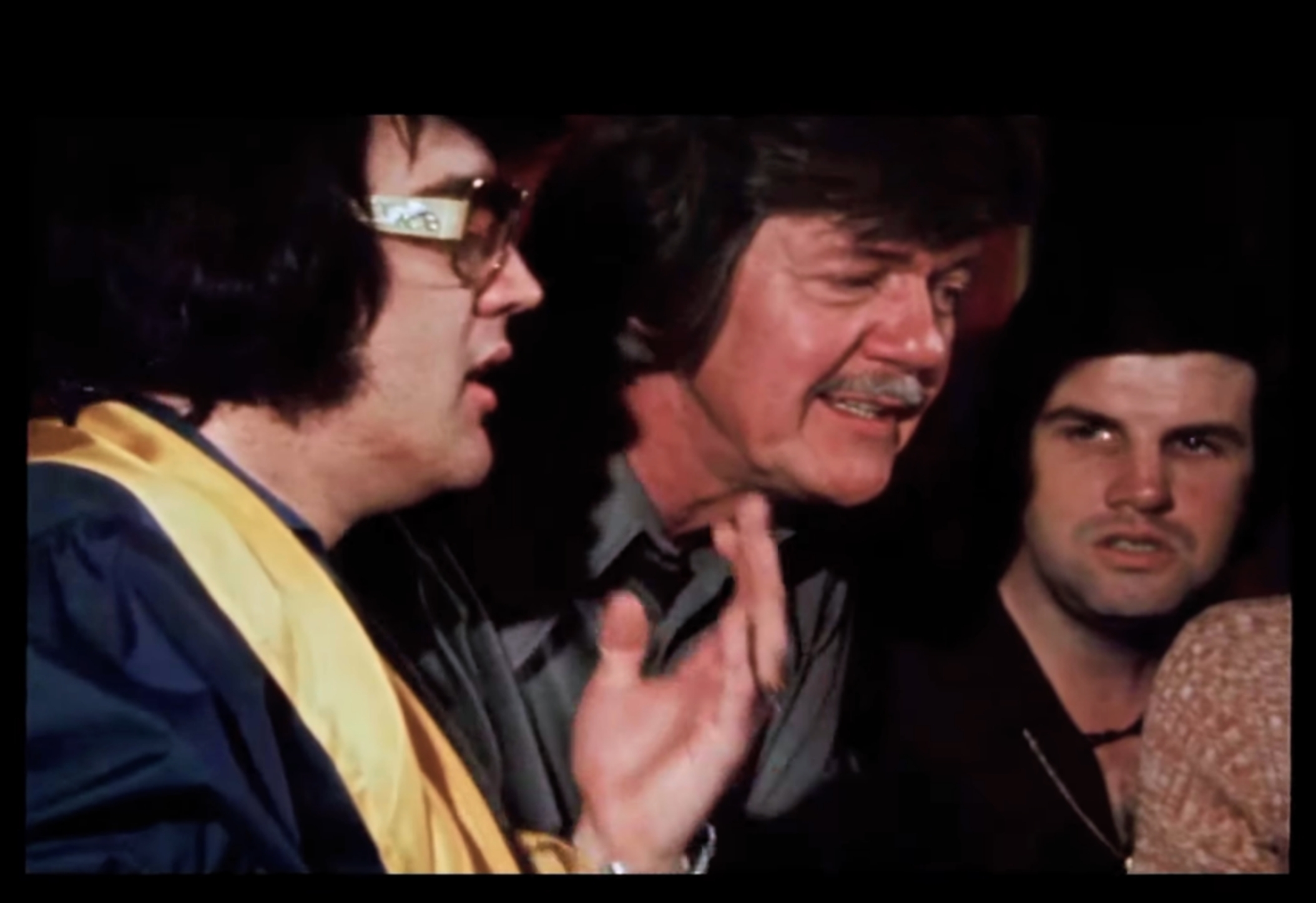
-

-

-
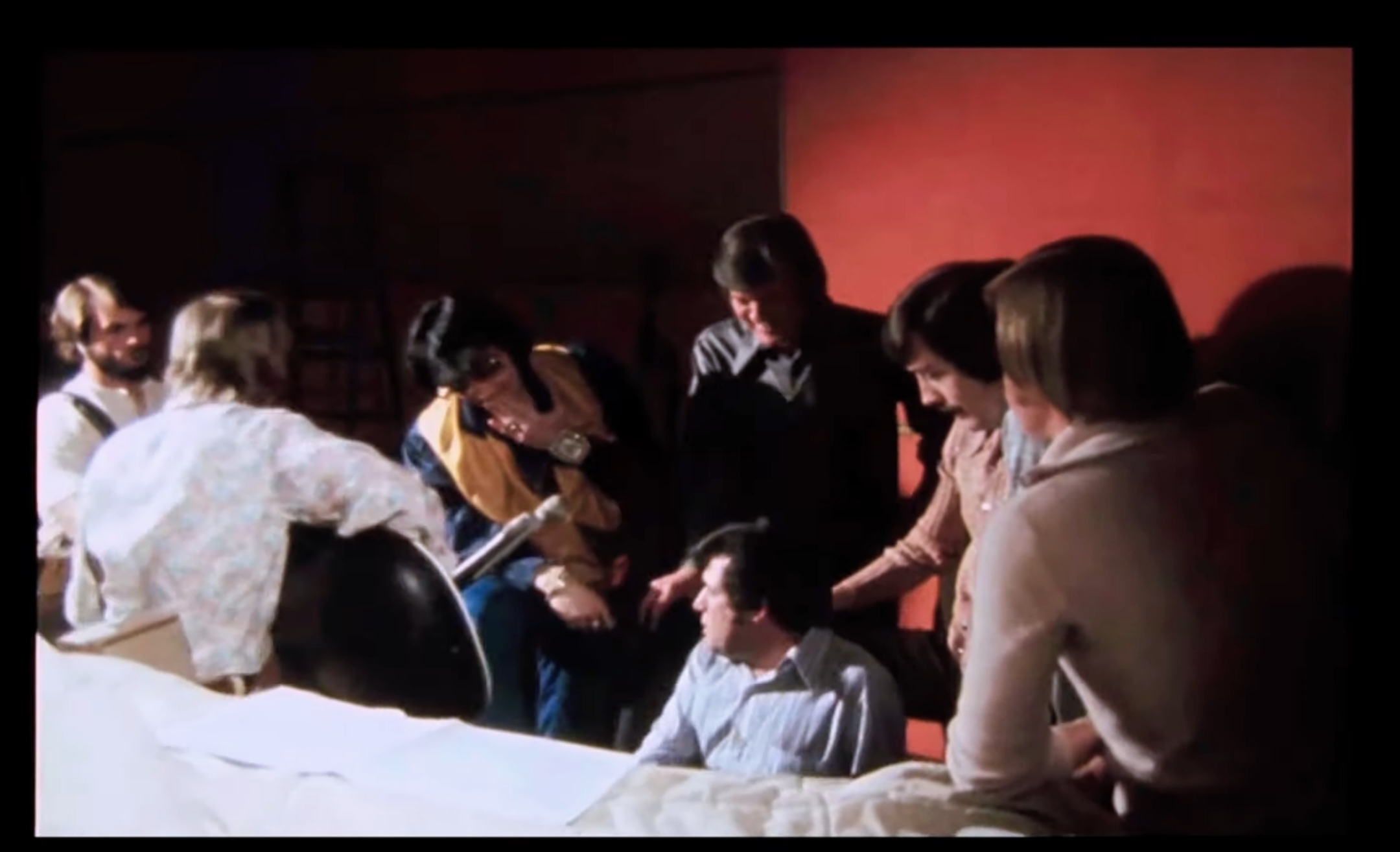
-

-
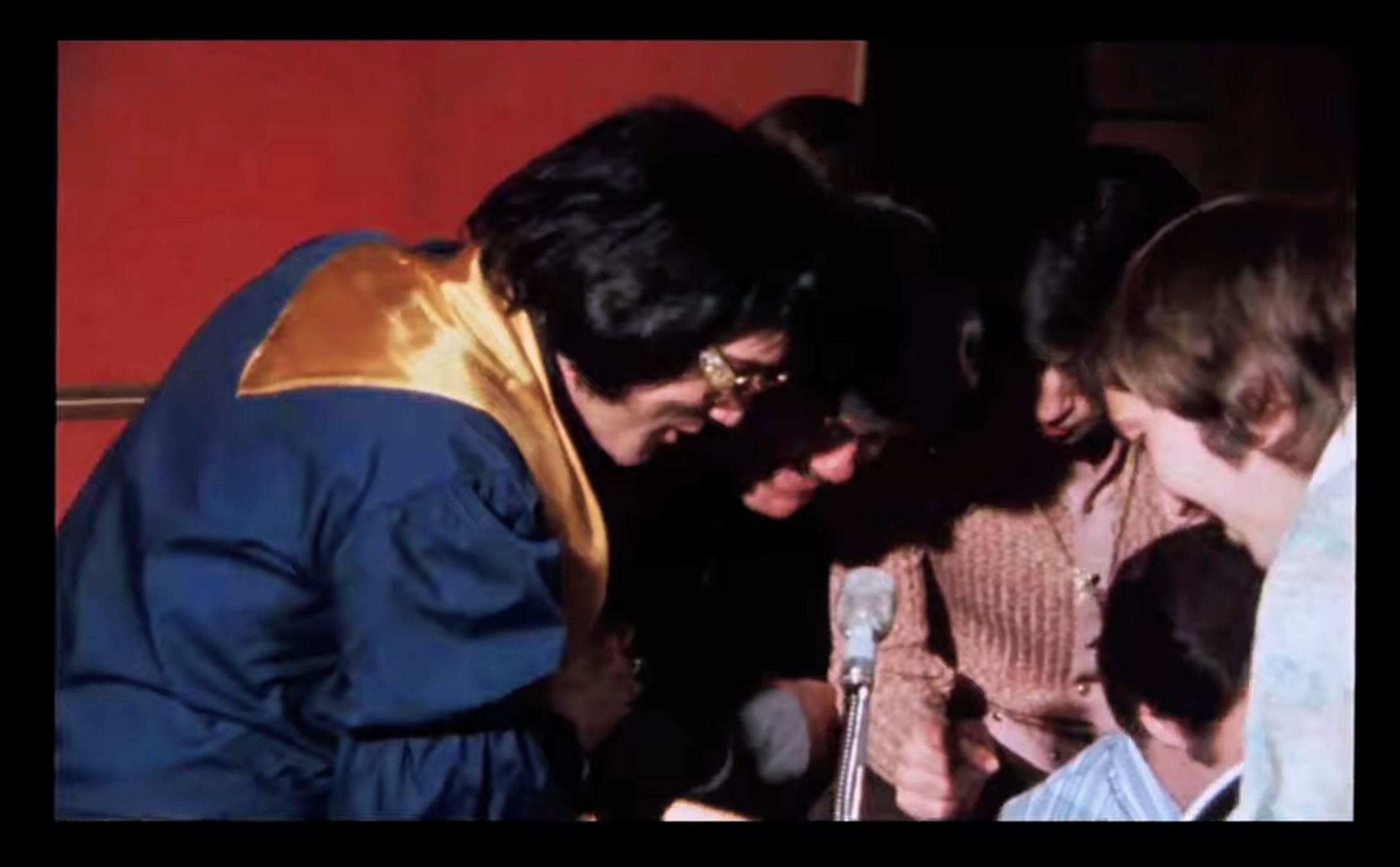
-
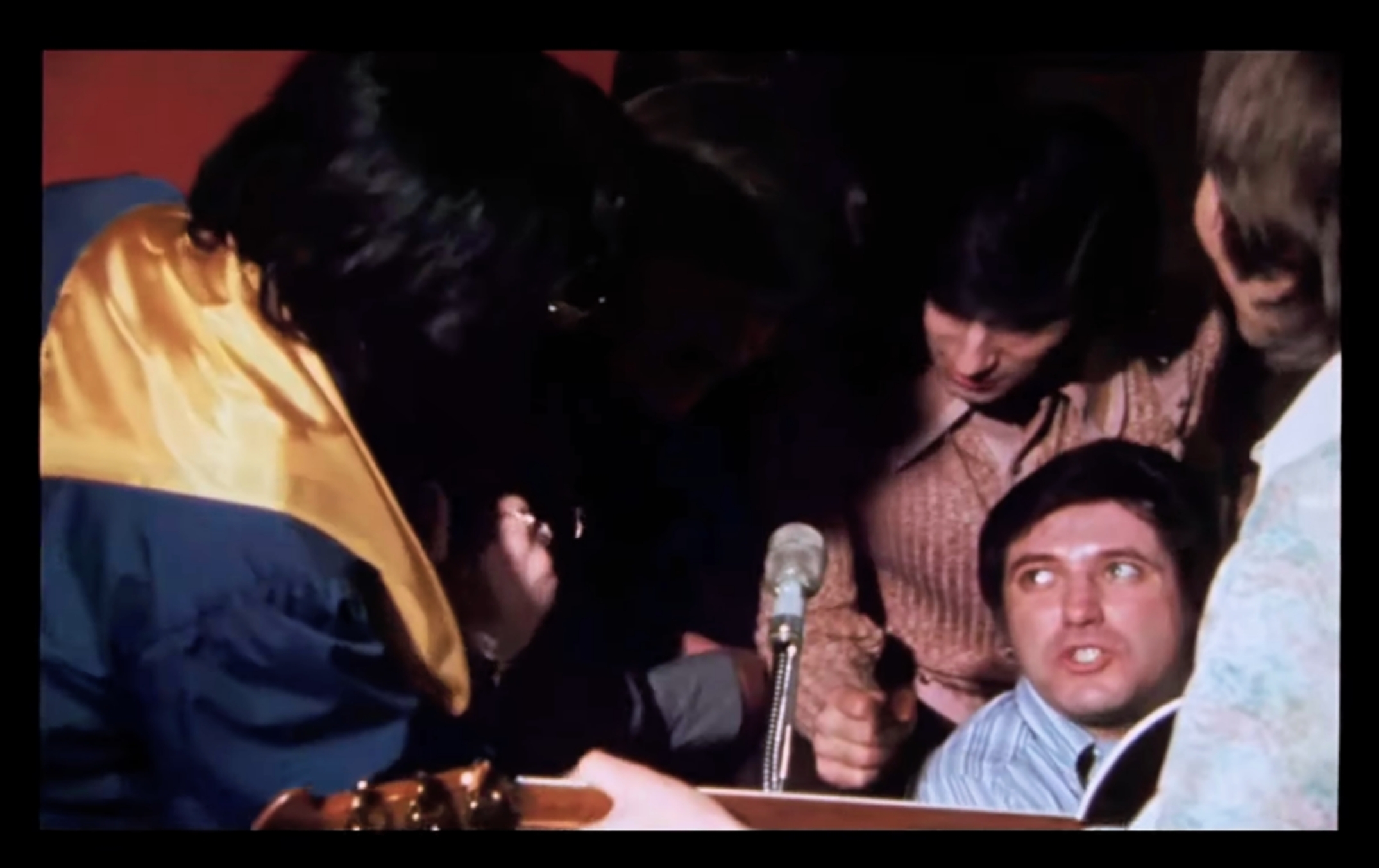
-

-

-

-

-

-

-

-
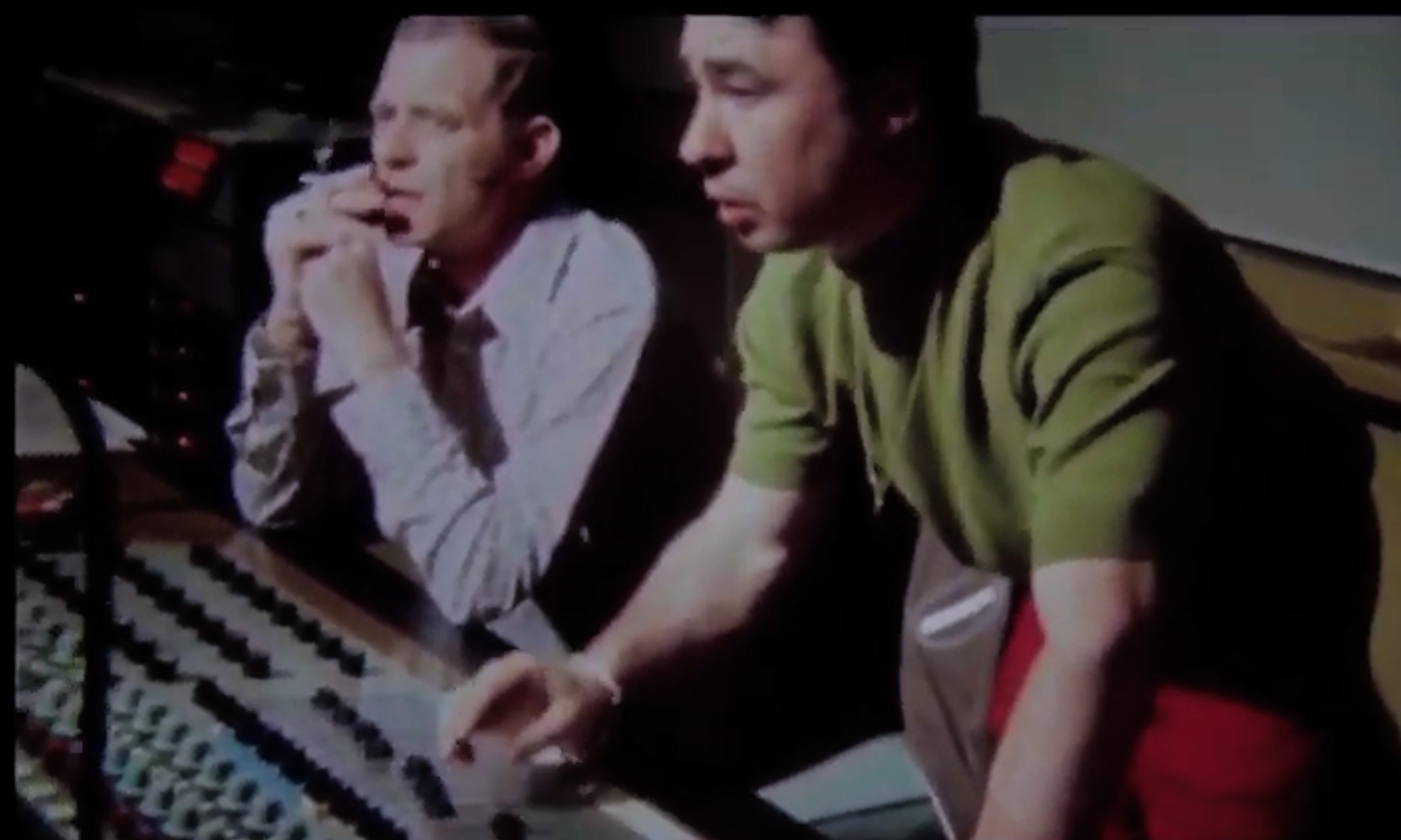
-

-

-

-
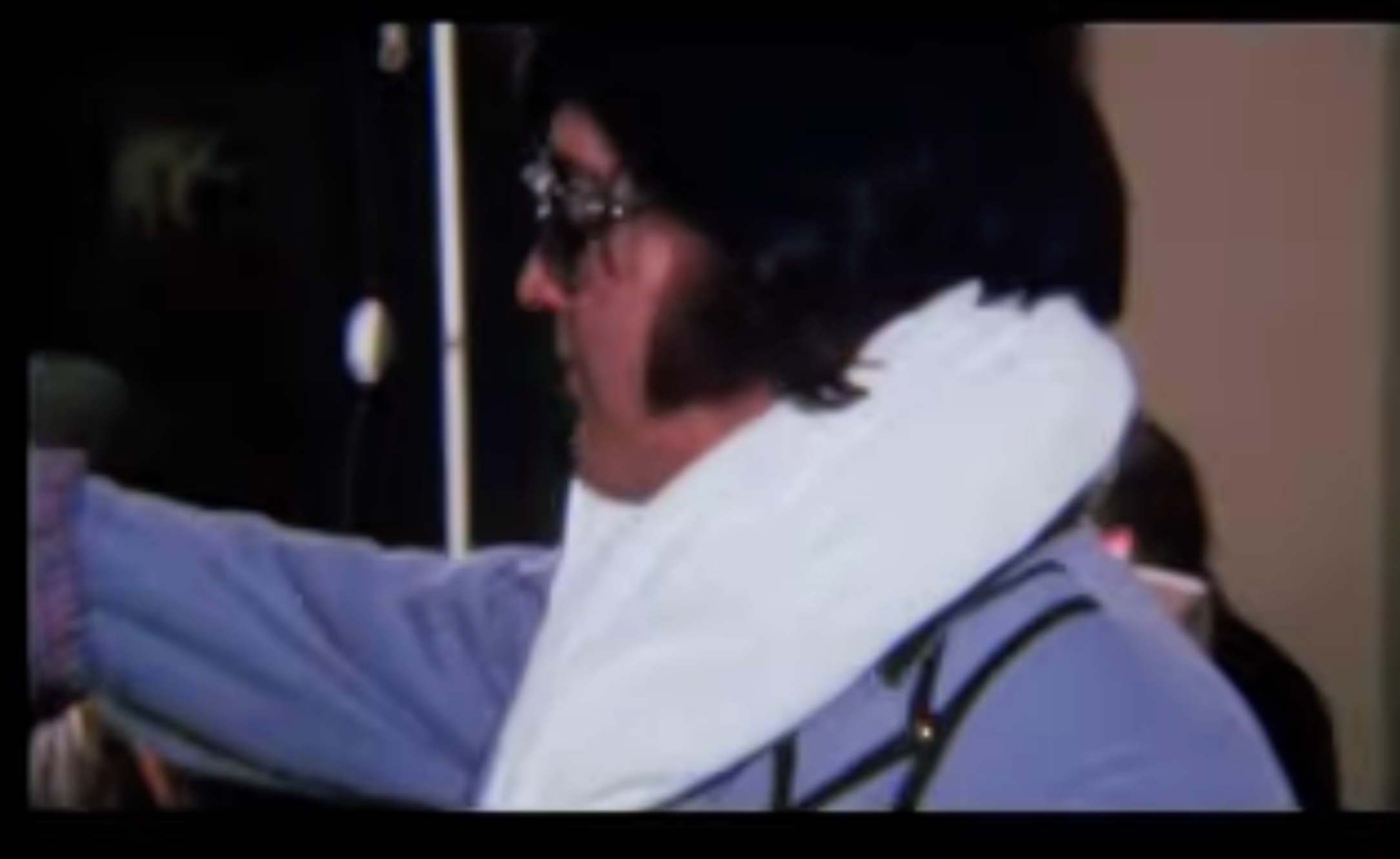
-

-

-
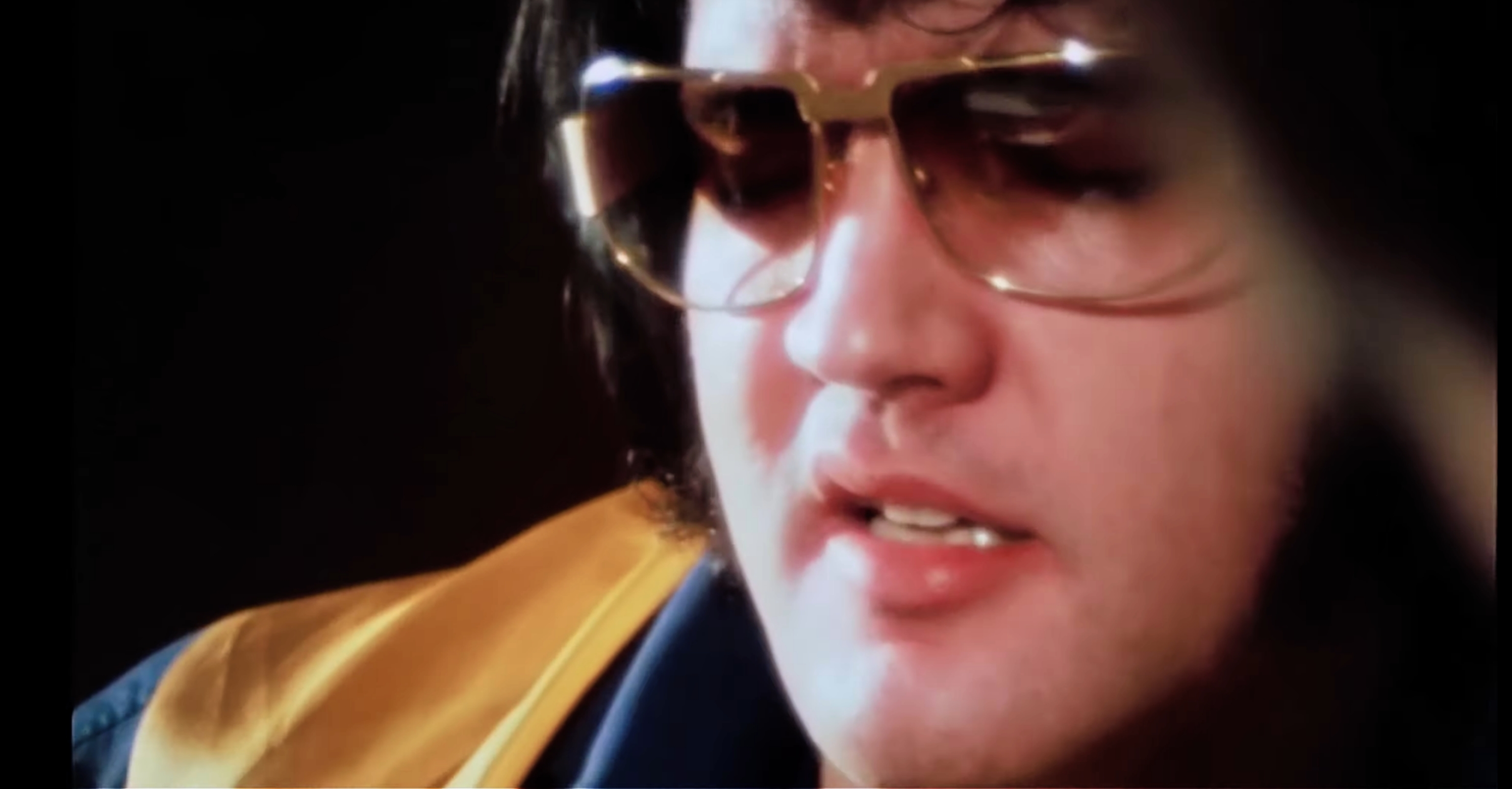
-

-

Concerts April 1972. ELVIS ON TOUR
. This was something he had done before when he was making movies, he had a tendency to put on weight and was looking again to go on a diet to correct what he had done in leisure time. The tour was scheduled from April 5, which would begin at the Buffalo Memorial Auditorium to April 19, at Tingley Coliseum in Albuquerque.
On this occasion, his concern was maximum, since he wanted to look good before the filming that was going to be done by the MGM team, both in the studio and in concert, and also at all times he would be chased by a camera. .
Elvis was not entirely convinced of these films, despite the fact that these two directors, Pierre Adidge and Robert Abel, already had his experience and had already filmed artists like him. Although The Extreme Starvation Diet was rigorous for him, it made him lose a few kilos, the physical appearance of him looked different during the tour. He had gotten to the right weight, but his face was puffy, he looked tired, and his skin tone was a little whitish on camera, despite his personal good looks.
During these performances, the concerts were of the highest quality, the public responded with applause and shouting. The orchestra was now performing better than ever on tour, and his musicians followed him along, as did his choir. Despite the fact that Elvis's performance is always compared to previous times, he was dignified and in many moments he is seen pending everything on stage, the public, the choir, observing and letting himself be carried away. It is true that his attitude is sometimes too static on stage and that he is not as dynamic as two years ago, but his interpretation is good and the movement does not detract from his concerts.
Simply the way he was on stage had changed, every artist evolves and can make changes, consciously or unconsciously, but it was clear that Elvis was different, but it would not be worse for that.
This documentary showed that he was at his best as an artist, the audience records, the box office, the critics... everyone agreed on the recognition of his claim as the best and greatest. What would add points to his performances from then on would be his karate movements with which he did some different shows and the inclusion of these exhibitions to which the public was not used, since at this time karate was not entirely popular in the US. This would make up for Elvis's other form of acting of yesteryear, his moves... but it's true that the public is going to take him into account in songs that were known for this. Adidge took a tour with Colonel Parker so he could see all the Concert halls and choose the most suitable places for the recordings of this film. In total, about 50 hours of Elvis concerts were recorded, but it didn't really matter how much they planned the camera angles, they just filmed the artist and the audience's reaction.
The reason was that they did not know in advance what Elvis was going to do on stage, he always did something different and surprised them at all times with his attitude. It was difficult to follow him because nothing was studied, as he said, he acted as if he were singing the song for the first time and he himself had not studied his gesture or his attitude on stage. To get maximum results from the filming of these concerts, Pierre Adidge made a video recording of the first concert of the tour, in Buffalo. Since he wanted to learn the Elvis show himself, study it so he could make the film better and find the best camera angles they could do.
The film was shown to the rest of the film crew and 5 days later, they were ready to shoot. Elvis was a bit cautious and was not entirely convinced with this film, only when Elvis was able to view the recordings of Hampton Roads on April 9, he would see the optimal result that they were having and then he would give his approval to these two directors. They filmed that night's concert in Hampton Roads, continued the next day in Richmond, and later in Charlotte, Greensboro, and San Antonio. At the concerts we are going to be able to see great performances and above all an enthusiastic audience that is faithful to his idol.
"Following the Path of the King..."
FROM TUPELO TO MEMPHIS 69 ELVIS ON TOUR. The Concerts. (documentary film April 1972)
The Elvis Effect
The shocking seconds in the lives of his Fans
"Elvis On Tour" documentary film. It is very interesting to observe throughout the footage of this documentary, the attitude that the audience had towards Elvis.
The reaction it provoked, everything he unleashed in front of his audience... the energy, sexuality and above all that magnetism. Not only in the music, his voice, the reaction with all his feeling in the interpretations of his songs and the way he influences his fans at all times during the concerts, just as he was, his way of being, his attention both on and off stage.
They were moments of emotion, of hysteria, of joy, any description is very far from reality and it is very interesting to see the attitude in general because we would understand their fans even more. In these scenes filmed throughout the film, you can see how the public applauds, shouts, is surprised, laughs, they are shouting Elvis, Elvis, Elvis all the time.
And the most surprising thing was the attitude of the artist in concert, since Elvis normally always turns around to see who is yelling at him, as well as getting closer, if he can.
At all times attentive to his fans, he not only attends to them, but also pays attention and follows them in attitude, the complicity between the artist and the spectators is great.
Many interesting moments could be described in this film, but there is a very nice moment in particular, in which a fan approaches him and wipes the sweat from his face, Elvis is kneeling in front of the young woman and takes the scarf that she is wearing. his neck, he gives it to her, then he kisses her.
It is one of the most striking moments of this film, it is not only an act of admiration, a loving moment, very touching, seeing how the girl caresses him with her handkerchief and carefully wipes the sweat from his face, Elvis reciprocates by giving her away and surrounding her neck with the handkerchief as a reward, Elvis approaches her and finally kisses her.
The look is the reflection of the soul, only a few seconds that remain forever in the memory as a beautiful and special memory, the look of the fan is transparent, it is all love and tenderness.
Elvis gets up realizing that his chain caught the microphone, this scene is followed by a humorous one, with the expression of Elvis releasing his microphone, looking at the rest of the musicians... he always had a spontaneous attitude on stage and this is another try more.
There are a lot of moments in this movie that could be fun to watch, like when at the Hampton Roads concert, Elvis gets a bra thrown onstage. We all know that women adored Elvis, idolized him, they and men too. In 1972 he was still like that, although physically he had matured and could have changed, he aroused passions, and in this concert, when he is singing the song "Love me", a bra comes flying and falls next to him, on stage.
When Elvis sees it, he doesn't know what it is... he lets it go at first, but his curiosity makes him bend down to pick it up and with surprise he sees what it is, the face he makes says it all. Since he is a joking man, while he sings he puts it on his head as a hat and enjoys the grace of it... the rest too.
The audience laughs, the choir and the musicians burst out laughing and Elvis obviously keeps playing with the bra, keeps singing with it until he gets tired and gives it to the choir, following his show. Other moments that are among the most common in his shows, in which the images in which Elvis approaches his fans are particular. In one image he first kisses a very attractive blonde girl, who turns around in amazement, as if she had been left on a cloud, they were Elvis kisses. Another girl approaches him, whom Elvis surprises by kissing her. The fan doesn't even believe it... her impression is such that she turns pointing to his companions as if to say... "he has kissed me!".
We can get an idea of what it was like to witness his show, to experience the emotion in person of seeing him, hearing his voice and also being able to approach him to shake his hand or kiss him.
The fact is that in this film we can see above all, the joking and smiling attitude with which Elvis takes some unforeseen events during his performance. For example when they throw a red panty on the stage, quite striking because he takes it and keeps it in the hand looking... he continues with his performance but his face says it all. Elvis had a lot of humor and he obviously showed it naturally.
That's how Elvis was, a generous man at all times, especially when he is with his fans, because any other artist would have given a kiss on each cheek but Elvis gave a little of himself to his beloved fans with kisses. of the.
"Following the Path of the King...
ELVIS ON TOUR.
IN CONCERT
APRIL 1972
The film "Elvis On Tour" would be in some senses a sequel to the film, That's the way it is, in the 1970s, although with a significant, different and very important change. See especially in performances the way in which focuses almost equally on Elvis and his fans, his attitude, his reactions, the multitude of spectators who tell of their love for the artist, their fidelity and sometimes their surprise, together with the way Elvis Presley does the show, his talent, his spontaneous daily vision on stage. "Elvis On Tour" also shows an inside look at life behind the scenes at Elvis. Many times we know the artist, but we don't know anything about him, what he thinks, what he feels and sometimes not even It would not even be necessary, but it is easy to understand the figure of Elvis in 1972, if we listen to his voice, explain his feelings created by past situations.
This documentary film also shows the focus on the realization and experimentation of the scenes made by or the directors of him. Everything would be filmed in concert, from different angles and sometimes dividing the screen into three approaches to the performance. Elvis was frank, direct and natural, both on and off stage. He was so honest that he offered us one of the most important documents, his voice and direct confession, explaining about his artistic career, his feelings of frustration at the handling of his films... He gave Abel, the director, more access, than many directors would have expected.
The film is most famous for its multiple split-screen shots, a visual technique, showing Elvis and the crowd from multiple camera angles simultaneously. This way of making the film, this visual technique, was going to be used again in the live broadcast for TV, at the Aloha from Hawaii concert in 1973.
The first time this technique was adopted for filming in concert was at the 1970 documentary "Woodstock". In which Martin Scorsese participated as an editor, who would contribute his knowledge in this film. As for the performance, in some cases brilliant, in others more moderate, but generally good. The show has the same structure that you have done before.
Elvis continues to include his karate innovations and emotion through songs that will impress the public, such as the inclusion of the theme "An American trilogy", which unleashed the public. As for clothing, the change is notable in the development of Bill Belew's designs. The simple white suits of the early days are left behind. The inclusion of rhinestones in them, give a little more weight to the suit, this may be why their movements in general are slower, but it would not affect their karate demonstrations.
The suits with more color and striking, of blue, red and black color, adorned with rhinestones in star patterns and adorned with a majestic cape on the back. Filming for Elvis On Tour wrapped in April and was scheduled for a November release. When it hit theaters, it became an even bigger hit than "Thats the way it is" and would go on to win the Golden Globe for best documentary film. The profits would be optimal considering the initial expense and the benefit was immediate.
"Following the Path of the King..."
April 1972
Elvis Performance in Concerto.
A tour scheduled for 15 days in 1972. Of which we will be able to witness during the filming of the movie "Elvis on Tour", four of them. The lights go out and everyone knows that it is time, the public feverish by the overture with "Also spracht Zaratrusta", is awaiting the entrance of Elvis. And finally he comes out on stage, safely with elegance and above all with strength. He addresses his audience singing "See, see, rider", to heat up the atmosphere even more. The songs that follow are always familiar to us, we can also listen to new repertoire that he has recently recorded. It is true that the artist with years of experience , he no longer has the nerve on stage he no longer moves in that nervous way, trying to control his audience. He really doesn't need it, because maturing what he does is generate a certain tranquility, security on stage. It's not that he lacks motivation or inner nerve, it just seems like he's calm inside, but that's not the case. Elvis has always confessed that when he goes on stage it's as if his audience were coming out again, something new like his first time. For this same reason you will never see him completely relaxed, but the truth is that for the public, this is another Elvis, who has nothing to do with the 50s. He is a different singer both in his voice and his movements such as interpretation but life is the path that changes our experience step by step and this is what we can see in these concerts.
There were 15 days of performance, a tight tour, there are too many days in a row to not have any in the middle of rest. The truth is that an artist should normally rest at least one during the week, like his musicians, but his tours were marathon for everyone. Both for Elvis, as well as for his musicians and logically also for the orchestra, hence obviously they can be receive changes from the first days to the last days of performance.
It was a very united group, they traveled by plane, by bus, depending on the distance and every day they would be in a different place. In terms of acting, you always have to take into account all the factors that are going to influence each moment, but Elvis always had a strong impact on the viewer.
The worst moment for the artist is the moment when he is going to go on stage, the corridor that goes to the stage, between boxes when he is listening to the music that gives entrance to the Show. When he feels that the public is stalking the exit of his idol, this would be the moment when he could get more nervous, because really if he is not concentrating, the nerves invade the interior and cause fear in many moments.
What is commonly called stage fright, Elvis always confessed that he had stage fright and that throughout his life it would haunt him in all his performances until the last. But once he enters the stage, he sees the audience, hears their screams and it invades him. the music, everything goes smoothly... the artist concentrates, begins to sing, begins to enjoy and Elvis above all enjoyed seeing his musicians improvise, seeing his singers dance and with this offer the best of himself every day .
In this film "Elvis On Tour" we can see that the images are intermingled from the beginning, when he talks to the boys, when he is going to go on stage they tell him that there is a problem on stage and then he goes on stage and begins to sing . Rehearsals, recordings, interviews, delivery of the keys in the City of Roanoque, Virginia. Finally, images of concerts in which we can enjoy his performance and the making of a film that shows us Elvis Presley and his team from one place to another, entering and leaving the stage, etc.
As a whole the film reflects the type of shows that he does in 1972 and the absolute success that he has at the moment .
"Following the Path of the King..."
The designs of Destiny.
Dreams and fear.
Elvis still had hope in his future, in his music and his personal life, he put it aside to move on. It was a moment for him, of definitive change, but for this he would not leave anything undone... on the contrary, his intention was to be able to offer the best of himself as an artist. This documentary film "Elvis On Tour" had excited him, said Jerry, but he was not receptive and seemed a little reserved, even with this, Elvis took the filming very seriously, because he knew that it was his concerts, his work that he would be in the movie again and he wanted to do it right.
Jerry, for his part, collaborated in the production part as an assistant, in the editing of the film, thanks to his experience in Hollywood, for two years. His help was also special for those responsible for the film, Pierre Adidge and Robert Abel, for to achieve maximum collaboration with Elvis, since they knew that he did not like very much the idea of using photographs to make a montage that would be included in the film.
The idea of including the photographs of the past would be accepted by Elvis thanks to the influence of Jerry who told him about the realization, although at first he did not want to do it, he would finally accept. During concerts, rehearsals, recordings... they were surrounded by cameras at all times, following Elvis and his bodyguard, his musicians and the entire team.
Although it would be uncomfortable, they had to get used to it, since it would be in a natural way and they were no longer aware of when they were being filmed or not. There came a time when they did things that they normally would have done in any normal situation, such as the jokes that Elvis made...
https://www.youtube.com/watch?v=loryP4ZlE8Q
At this time Elvis had another project in mind, since he wanted to do an international concert tour. It was a great illusion that he had always had in mind for years and Jerry heard him talk about it on several occasions, he knew that Elvis wanted to travel abroad. The idea of performing in England, in the rest of Europe and also in Japan, was open to being able to do a big tour.
He was aware of all the fans who made the trip to Las Vegas from anywhere in the world and Elvis spoke with real passion about doing an international tour. They sat down to talk about his dream, but he also spoke angrily to her for not having done this project earlier. Years ago, Colonel Parker, his manager, had already influenced him to avoid proposed tours in Europe and would again be the one who was going to prevent him from doing what he wanted.
The emotion of acting again was what moved him, the film would also have opened doors for him and he wanted to have the freedom to make his own decisions. But he wanted a change of scenery, to change his life, to be able to meet his fans outside the usual places and surely it would have been something that could possibly have changed his life. He wanted new challenges and many proposals had already been made to him to do concerts in Europe, which had been rejected.
The next day he had to see the Colonel and wanted to bring this up, so Jerry started talking about it to mediate between the two. This conversation would irritate the Colonel who didn't want to talk about anything like that, going on tour outside the US was not in his plans and he wouldn't let anyone get in his way.
For this he would always have the capacity for persuasion, the ease of instilling fear with many arguments to prevent Elvis from traveling through Europe, as was customary for him, everything was actually a reason to hide his own interests. There are people who insist on wanting to instill their own fears, their frustrations, simply because they do not dare to face their lack of courage to face new situations. The purpose is so that we cannot move forward and change our course... and the Colonel was an example of this. Unfortunately, Elvis could never realize this dream, again Tom Parker would be his stone, his fear, his obstacle... his lack of vision made him never see through other eyes out of fear. failure.
The possibility of doing an international tour would be another
impossible dream...
"Following the King's Path..."
FROM TUPELO TO MEMPHIS 69
ELVIS ON TOUR. The Concerts.
(documentary film April 1972)
Anecdotes in Concert."Elvis On Tour"
Documentary Film April 1972
These things could happen if the fans managed to get to the stage, so his safety would be very important, it was one of the reasons why he would
It is the moment in which Elvis looks pensive, because he felt that he had not done well. There are many details that we can know, for example what happens when Elvis enters the car and travels to another new city or to rest from the performance. The effort he makes on stage, without any rest, takes its toll as soon as he sits down and everything falls on top of him. Feeling that not everything is well done, he asks how the Show was and his friends always cheer him on, regardless of whether Elvis may think he was not well done. In the car he is surrounded by his friends, his father, they all comment on the performance, play jokes and sometimes even sing.
Elvis leaves exhausted and all sweaty from his performance and we can see him thoughtful, immersed in his things with a distant and lost look... where no one but him could reach. When Pierre Adidge got into the limousine, he witnessed many of these moments, how he was courteous and gentle with people and on the other hand with his prankster group, he described it with a macho camaraderie. He heard jokes, small talk on several occasions since for 4 weeks they were with the whole group.
But Elvis's gaze into space made him think of how he felt over and over again during his younger years when he did so many concerts. At this time he included in the film the photographs that go back to success, to the past... it was a way of merging the present in the lost thought of Elvis and a look back... Rober Abel would witness how kind he could be Elvis in difficult situations such as being approached by an aggressive fan, Elvis told Abel that he didn't want to "spoil that person's moment". His attitude was always correct without thinking about how annoying the moment was, when everyone who witnessed the fan's attitude saw that he was really overdoing it. In these concerts of April 1972, they traveled as usual, one day in one city, another day in another... The places begin to be similar, the places where they perform too, the life of the Artist, difficult to live , if you don't love this profession enough. It is evident that the compensation for all this, Elvis had it with his public, the applause of him and that of singing and performing with his music on stage. At these concerts you can see the euphoric public at all times wherever you go, tickets would be sold out and this documentary film gives us an idea of what this moment of success was like on the Elvis Road."Following the King's Road.. ."FROM TUPELO TO MEMPHIS 69 ELVIS ON TOUR. The Concerts. (documentary film April 1972)
JUMPSUITS IN ELVIS ON TOUR.
APRIL 1972
Jumpsuits Abril. 1972:
O Blue Nails suit It is a light blue suit, it is adorned with large silver eyelets around the neck and on the side openings of the chest, with white lining. Around them are flat silver studs, which could look like nail heads. They also adorn the pants, the back and the sleeves. The suit has six white cufflinks, three on each sleeve.
The coat of the same color, but with a white lining. The ensemble was adorned with a white scarf or kerchief. The belt with five large metal medallions and with two gold-colored chains that surround the belt.
Elvis wore this suit for the first time in Las Vegas in the January-February 1972 season, also in April and it is believed that at the Summer Festival in Las Vegas again. The last time would be on November 9, 1972, in Lubbock, Texas, in which Elvis curiously threw the belt to the public almost at the end of the concert. He sometimes combined it with the "White Firework" belt, instead of the original.
RED LION SUIT with red lining cape.
original belt Also called WHITE PINWHEEL or Grinder suit and sometimes called MATADOR BLANCO White jumpsuit with five large gold eyelets on each side of the chest opening and around the neck, lined with red cloth. it was strengthened or expanded a little. Around the eyelets with eight pyramid-shaped studs. Adorned with three red cufflinks each on the sleeve cuffs. On the trouser legs, he wears a red cloth opening.
Adorned with a white leather belt, with five gold metal lion heads on a red background, with four gold leaves around. The belt has two gold chains with seven bows around it.
During tours, Elvis had a habit of sometimes taking off his belt and putting it on his shoulder. White cape with red lining, with the design of the suit. He adorned his neck with a red scarf. Elvis first wore this suit in Minneapolis, Minnesota on Friday November 5th, 1971.
Also in Las Vegas January-February 1972 and on the April 1972 tour and on April 18, 1972 in San Antonio, Texas.
WHITE FIREWORKS with red and blue lining layer.
Original belt White Fireworks Suit. An earlier Black Fireworks was made, which had a similar design, but the pattern was more of a star shape on the studs rather than round. They were arranged higher on the chest and distributed to the shoulders, and the outside of the sleeves and legs. It has five large gold eyelets on each side of the chest.
On each cuff of the sleeves there are three light blue cufflinks. The neck is lined with a green fabric surrounded by stars. The opening at the end of the trouser leg has the same light. Blue factory.
The cape is white with six small firework patterns and one huge one in the middle, similar to the pattern on the suit, lined with light blue fabric. The large leather belt is white with light blue triangles, in the center of the buckle there was a gold medallion with a drawing of a horse rider.
On the belt there are two similar medallions and two large pyramidal gold-colored studs, with studs adorning the rest of the belt. He wears colored chains hanging in five bows around his belt.
This belt was combined with other suits, because Elvis liked it very much. The neck was adorned with a blue scarf. The suit, sometimes called White Starburst, was first worn by him in November 1971 in Louisville, Kentucky. In January-February in Las Vegas 1972, the last time Elvis wore this suit was April 19, 1972 in Albuquerque, New Mexico.
o SPECTRUM SUIT with black lining cape and blue lining cape. original belt Or Snowflake. It is a large white jumpsuit with five gold eyelets on each side of the chest and also around the neck, it is lined with black fabric. Surrounding the eyelets are eight round gold studs. It has patterns on the back, on the chest and on the outside of the sleeves on the trouser legs, divided into black lining. On each cuff there are 3 black cufflinks. The white cape, lined with black cloth, has nine lines with two patterns.
The belt adorned with five large black patterns with gold studs all around and also square studs of different sizes. With two gold chains in seven bows around it. The neck was adorned with a black scarf. It was also called Spectrum because it was used for the first time in this city on November 8, 1971. The suit was also used in Las Vegas in January / February 1972 several times. On the April 1972 tour.
BURNING LOVE SUIT or RED PINWHEEL SUIT, with White Lining Layer.
Gold assist belt. It was a red or maroon jumpsuit with the same pattern and design as its predecessor in the grinder. The fabric of the pants opening is white, as are the cufflinks and buttonholes around the chest opening. The outside of the cape is red with a pattern similar to the other Pinwheel models, the inside is white. The difference lies in the gold-colored rhombus-shaped studs, which it has as decorations. It was normally accompanied around the neck with a white handkerchief or scarf. The belt that Elvis used was the gold one for assistance, since the monkey did not have an original belt. It was called Burning Love, because Elvis was photographed with it and on the cover of the single of the song "Burning Love" said photo would appear. The first time it was used was in January-February 1972 during concerts in Las Vegas, on the April tour and for the last time it was used on November 10, 1972 in El Paso, Texas.
OWL SUIT OR ROYAL BLUE FIREWORKS SUIT, with Silver Lining Layer.
Original belt It is known as the Royal Blue Fireworks Suit. It was a Royal Blue suit with five silver eyelets embellished on each side of the chest and also adorned the neck. The eyelets are lined with a silver fabric inside and around them there are eight, small metallic star-shaped ornaments, also in silver. Star-shaped studs in various sizes make a kind of fireworks around the suit, on the outside of the sleeves and pants legs, and the front and back of the top of the suit. The lining of the pant leg opening is also silver.
On the cuffs of the sleeves there are 3 cufflinks.
Like the suit, the Cloak had decorations in a fireworks design and the interior with a silver cloth. The royal blue suede belt made of leather, adorned with gold and silver studs, in different sizes, which were star-shaped. With four metal owl heads surrounding the belt. In addition to wearing chains in gold and silver. He dressed in Las Vegas in January-February 1972, also on tour in April and November of the same year.
White suit adorned with pyramidal studs in gold. V-shaped patterns on the sleeves, on the outside of the sleeves and on the pant legs, around the upper body of the suit and on the back. With five gold colored square eyelets on each side of the chest and on the neck. All made in yellow lining. On each sleeve cuff with 3 yellow cufflinks. On the pants there was the same yellow lining in the opening below the knees, with the stud pattern. Like the suit, the Cloak had pyramidal studs on the outside. On his neck Elvis wore a yellow scarf or kerchief. The suit did not have any original belt, so Elvis wore the gold Assist Belt. Elvis first wore this suit in January-February 1972 Las Vegas, on April 6, 1972, in Jacksonville, Florida.
-
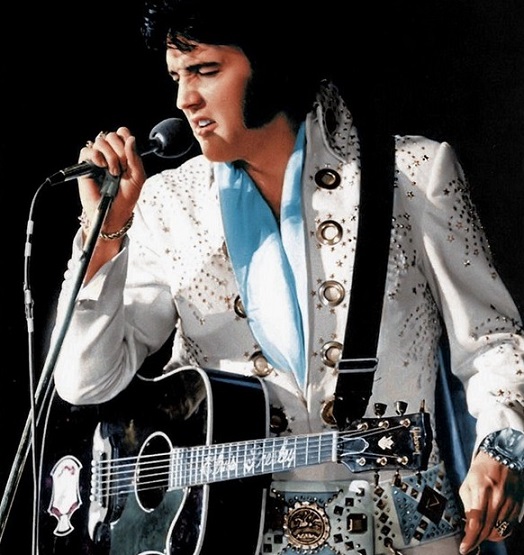 WHITE FIREWORKS SUIT
WHITE FIREWORKS SUIT
-

-
 WHITE PINWHEAL
white pinwheal o red lion suit, 15 abril de 1972 en Macon.
WHITE PINWHEAL
white pinwheal o red lion suit, 15 abril de 1972 en Macon.
-
 WHITE PYRAMID SUIT
16 DE ABRIL DE 1972 JACKSONVILLE MATINEE SHOW , WHITE PYRAMID SUIT
WHITE PYRAMID SUIT
16 DE ABRIL DE 1972 JACKSONVILLE MATINEE SHOW , WHITE PYRAMID SUIT
-
 BLUE NAIL SUIT
BLUE NAIL SUIT
-
 OWL SUIT
Owl Suit o Royal Blue Fireworks 14 de Abril de 1972 Greensboro.
OWL SUIT
Owl Suit o Royal Blue Fireworks 14 de Abril de 1972 Greensboro.
-
 WHITE SNOWFLAKE SUIT
8 abril de 1972 WHITE SNOWFLAKE Suit o SPECTRUM SUIT con Capa forro negra
WHITE SNOWFLAKE SUIT
8 abril de 1972 WHITE SNOWFLAKE Suit o SPECTRUM SUIT con Capa forro negra
-
 BURNING LOVE SUIT
9 Abril 1972 Hampton Roads. 02.30 pm show. Burning Love Suit
BURNING LOVE SUIT
9 Abril 1972 Hampton Roads. 02.30 pm show. Burning Love Suit
Elvis Presley On Tour
The world knows the artist, the myth... but few people know the man behind his music. Fame is the goal, it is a contradictory world between success and sacrifice. Everything entails hard work and many obligations to obtain the expected benefit and sometimes it is not enough to obtain it. You can be at the top, but then you have to maintain it, because there are too many factors that determine whether success is lasting or a shooting star of the moment. The harsh reality that is found in that double face, the image always in sight, the smile, the delivery to the public... The live show requires special energy and effort, security and above all a unique experience for the artist, who gives everything on stage. Nothing can stop the performance, the scene continues and everything happens in unique and special moments that make the viewer enjoy without equal. Elvis Presley, the man and his story ... everything is forgotten when he goes on stage, his voice conveys more beyond his feelings, life comes out through his performance and the public goes crazy with his show. Through the Film "Elvis On Tour" we can get to know a part closer to his protagonist, in his experience, in his performance and in his words. But the truth is very likely that we will never know it.
"Following the Path of the King..."
Growing page...
Sorry for the inconvenience!



































































































































































